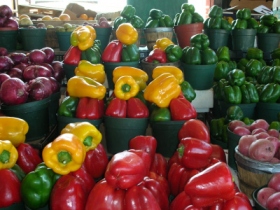Which of these bell pepper colors is not like the others?
|
Bell peppers at the Dallas Farmer’s Market, by joe beasley, on Flickr
|
Although the history of pepper cultivation goes back at least six thousand years, bell peppers didn’t show up very often in American recipes until domestic cultivation began around 1925. Unfortunately, there’s a lot of confusion about the different colors of bell peppers on the market and the significance of those colors. Let’s talk first about what goes on with the colors of bell peppers, then what that information means to us in the kitchen.
But to understand this conversation better, be aware that peppers are a lot like guys: just because we’re fully grown doesn’t mean we’re fully matured. That is, a pepper can have a fully-developed shape but not actually be ripe yet.
All bell peppers–and all peppers, in fact–start out in some shade of green between greenish-yellow and full-on “it-ain’t-easy-bein’-green.” From there, there are three possibilities:
- The pepper is green, grows to full size, and then ripens and turns a different shade of green.
- The pepper is green, grows to full size, and then ripens and turns a different color–for example, a green pepper that turns yellow when ripe.
- The pepper is green, grows to full size, starts to ripen in one color and then turns a third color–for example, a pale green pepper that turns whiteish-purple and then finally red.
Once a pepper has entered the final stage of ripening, it can be picked and will continue to ripen off the vine, but a fully-developed but not-at-all-ripe pepper won’t ripen once picked.
So what does this mean to consumers? It means you should instantly be suspicious of green peppers that cost less than yellow or red peppers. All yellow and red peppers either are ripe or are entering the final stage of ripeness and are going to have sweeter, less fibrous flesh and double the vitamin C than unripe fruits.
Given that, you’d think that growers wouldn’t pick unripe green peppers. Unfortunately, peppers, like tomatoes, are botanically fruits.
|
Bell peppers growing near Blanco, Texas by G F, on Flickr, on Flickr
|
This is unfortunate because all fruiting plants have what’s called a “fruit load.” A healthy plant will continue to bud new fruit throughout the growing season until a certain amount of fruit is on the plant–at which point, it’ll stop fruiting until some fruit is removed. This is why vine-ripened tomatoes are often two to three times the price of other tomatoes; leaving the fruit on the vine costs the grower the opportunity to sell one or two more tomatoes that would’ve grown had they been removed.
The way to get the most peppers out of your plants, then, is to harvest them at the earliest possible moment. For yellow and red peppers, the earliest moment is in that final stage of ripeness–but for green peppers, harvesting when they’re developed, but not ripe, maximizes profit.
So it’s not that green peppers are bad, it’s that unripe peppers are bad, and many of the ones you find in a supermarket aren’t ripe. But there are exceptions; talk to your produce manager and see what he or she can tell you about the growers.
From the box of F.J. from Sun City, Arizona. Some cards suggest a family history in Missouri and Kansas.
Cabbage Salad
medium cabbage
1 green pepper
1 onion
1 cup diced celery
Cut cabbage and place in bowl. Place other ingredients on top. Do not stir.
Sprinkle with 1/2 cup sugar. Mix 1/2 cup oil, 1/2 cup vinegar, 2 tablespoons prepared mustard, salt, 1 teaspoon celery seed (optional).
Boil three minutes. Pour at once over salad. Cover and place in refrigerator. Stir when ready to serve. Best if set overnight. Keeps for several days in refrigerator.
Recipe from the kitchen of Hilda Hoadley.



